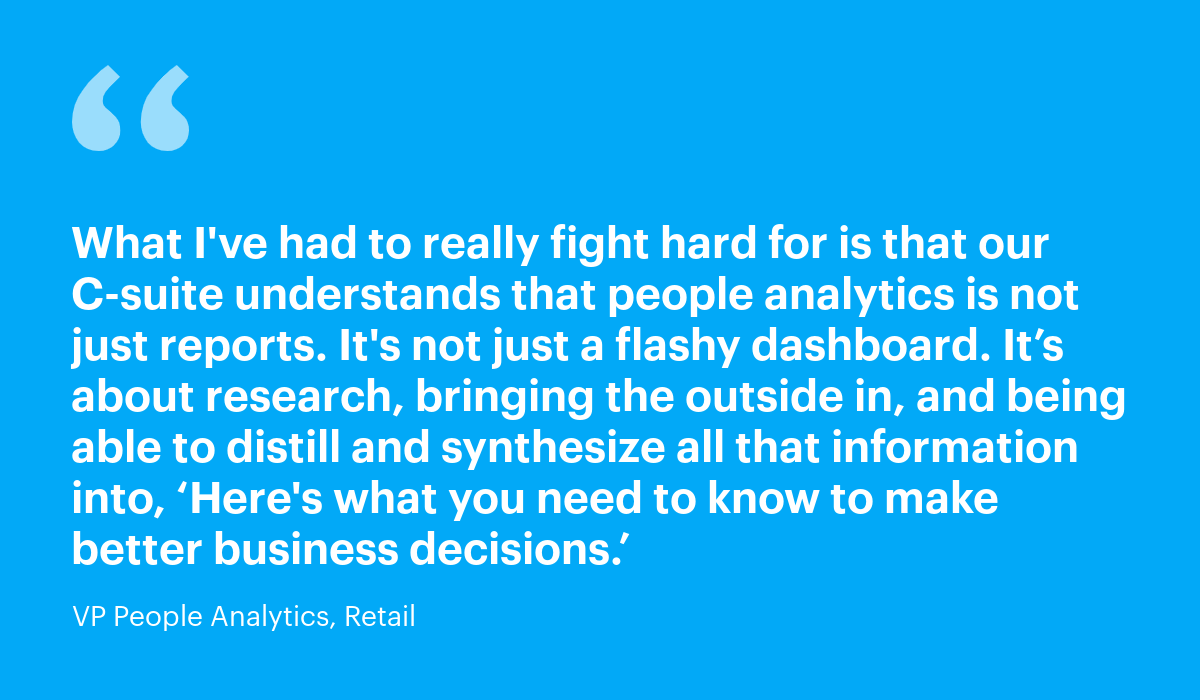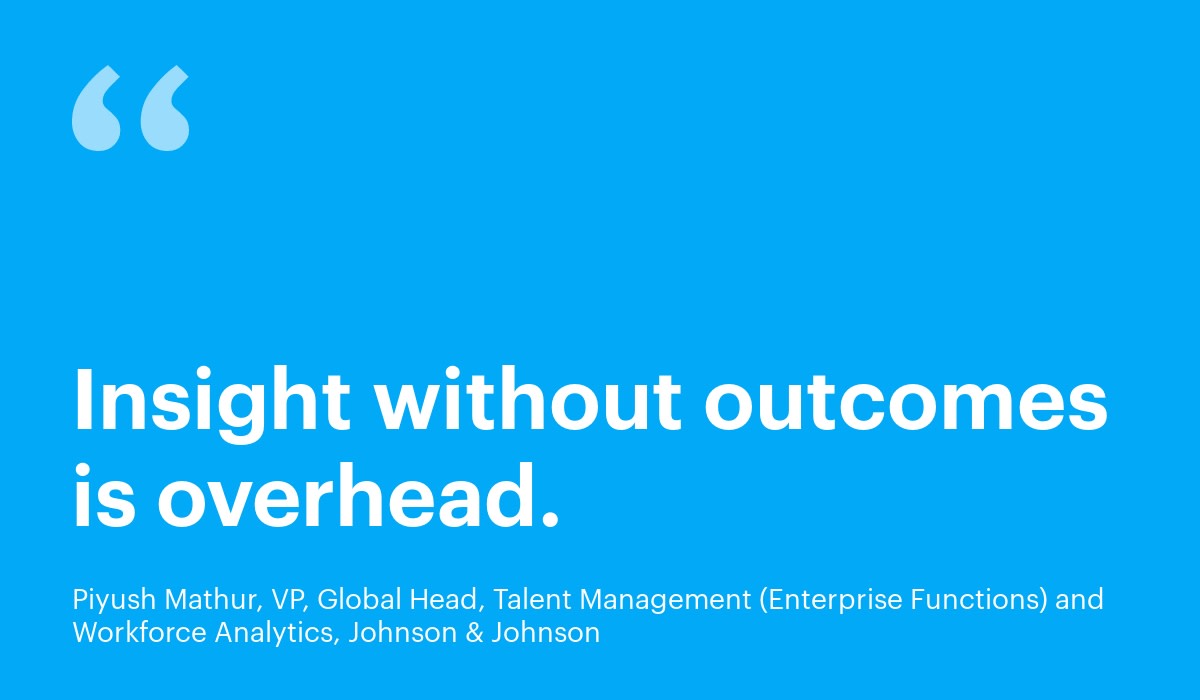Are You a People First Leader? What CEOs Should Be Asking of Their CHROs
While people analytics has been around for a while, most C-suite executives are yet to realize the strategic importance of it. Learn more.

As a CEO, if you were to rate how important people are to your business on a scale of one to ten, what would be your answer? Now, if you score how well you and your organization are using people data to drive strategic and operational decisions, is your score any higher or is it lower?
Do you measure your organization’s “leadership capital index” score? Do you know the market capitalization value of your leadership team? Investors are already starting to ask for the leadership quality of an organization to be quantified in a valid and reliable way. This is just one example of where people analytics can be linked to the bottom line performance of a business, but it goes much further.
When making major workforce planning, strategic capital expenditures, and large scale acquisitions, if your organization is not using people data to help drive these decisions, then you are likely making ill-informed decisions that are unlikely to be in the interests of your customers, colleagues, or shareholders. The reality is, while people analytics has been around for a while, most C-suite executives are yet to realize the strategic importance of it. What is the business value of people analytics and why do you need to put this higher up your agenda?

The business value of people analytics
In 2013, the film ‘Moneyball’ showed the value of data analytics in sports. It depicts the Oakland Athletics Baseball team’s 2002 success, building a team of undervalued talent by taking a sophisticated “sabermetric” approach to scouting and analyzing players. It is an inspiring advert for the use of data over human judgment. Over the last 20 years, there have been huge advances in data analytics in not only sport, but marketing, finance and now finally, HR.
7 Examples of successful applications of people analytics
Application: A few years ago, Experian’s global HR function found its global resignation rates were above the industry benchmark. Financially, every 1% increase in attrition was costing the business around $3 million. They wound up building a data-driven analytics solution to equip global HR teams with advanced insights into the levers and drivers of attrition.
The result: It helped predict who was going to leave, so they could act on it before they did. As a result, global attrition for the company was reduced by 4%, saving more than $14 million.
Application: Microsoft, like many of us, has grappled with the changes to our working patterns brought on by COVID. In some recent research they looked at activity data, and were able to show a 25% drop in collaboration time between cross-group functions. They also showed a 5% reduction in total meeting call hours, due to people working from home. This was revealing while they planned their hybrid working arrangements.
The result: Without this data, the policies they have in place today may have looked very different. Because of their insight, they have been able to make informed decisions on an emotive subject.
Application: National Australia Bank used people analytics to look at the people drivers of business performance in their retail banks.
The result: They found that people factors were responsible for 20-25% of customer satisfaction. They were able to show an increase of 26% in financial outcomes and improve 22 operational outcomes as a result of their work informed by people analytics.
Application: Virgin Media used people analytics to see how their customers viewed their company after being rejected for job opportunities.
The result: They discovered that customers were cancelling their subscriptions after bad experiences during their recruitment process, which was costing the company $5 million a year.
Application: IBM used AI to predict which of their employees were going to leave.
The result: They saved $300 million in retention costs using its predictive attrition model.
Application: Google identified that it took new hires an average of nine months to be onboarded.
The result: Google saved $400 million by reducing new hires’ onboarding time.
Application: The HR department used people analytics to help C-suite leaders understand critical business questions.
The result: Because of the insights and the resulting initiatives, they were able to reduce their attrition level to 23% in two years—which is the lowest that they’ve seen within the organization’s history. They saved approximately $3 million per year in costs to replace people and reduce the impact on productivity loss.
There are numerous examples of companies financially benefiting from people analytics, but how else could it help you achieve your strategic business goals?
How can people analytics help CEOs achieve their strategic goals?
People analytics can help with:
ESG
Around the globe, governments are passing laws on people-related reporting requirements of large organizations. In 2020, the U.S. Securities and Exchange Commission (SEC) required companies listed on the U.S. stock market to specify in detail three areas related to human capital: (1) Attraction, (2) Development, (3) Retention. In 2022, the U.K. government required all large organizations over 500 people and with more than £500 million to report on their diversity, equality, and inclusion data. People analytics makes this reporting easier because it is no longer a task that needs a lot of work, but data that is available on demand at the touch of a few buttons.
Employee experience and productivity
Some of the key drivers of productivity relate to employee motivation, well-being, goal achievement, and engagement. Being able to measure these in real time helps to ensure CEOs can act before problems arise.
Leadership capability
People analytics helps identify, recruit, develop, and retain an organization’s best leaders. It provides organizations insight into leadership capability, such as their people’s informal leadership score, the power of their collaboration circles, and the effectiveness of their communication. It helps to identify the ROI on leadership development, and accurately measures the level of behavioral change post-intervention or coaching. Using people analytics can vastly reduce the risk of putting the wrong leaders in the wrong posts, and help you to more objectively manage leadership talent pipelines.
NPS and customer outcomes
The colleague-customer profit chain has long been talked about. That is, if your employees focus on the customer, this improves customer satisfaction and ultimately increases sales and profit. By using people data such as eNPS, employee Net Promoter Score, and accurate behavioral data, companies are able to link this to customer outcome data, and identify the true impact of their employees on their customers.

6 Questions to ask your CHRO right now
Try to encourage them to make the connection between people and business goals. Link the people objectives to company strategy and ask the CHRO to report on this regularly.
Don’t just look for visualizations and descriptive reporting, stretch them to connect workforce and line of business data together so you can see actual correlations between people capability and business outcome data. Ask them to set hypotheses and test these with data to find evidence-based outcomes.
Look for a data-driven talent management review to deliver the talent pipeline the business needs. So often talent reviews are based on subjective data. Challenge the CHRO to collect metrics regularly throughout the year on people so they can objectively, and fairly, compare high potential leaders.
This should not be something just you have an interest in, you should encourage your CHRO to put people insights into the hands of all leaders. Have them democratize the data and empower other leaders to require it from their HR business partners.
Some of this progress will come from a change in culture and attitude towards data. Train managers to rethink people management and back away from gut instinct alone. Every good decision benefits from a human’s judgement, but on its own this is prone to error and bias. Ask for HR to have an analytics process that they can brand decisions with so you know the rigor behind it.
If they haven’t already got one, ask the CHRO to invest in building a winning people analytics practice. A proven people analytics solution like Visier will enable them to achieve all of the above in a quick and easy way.



